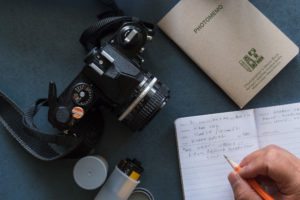
Film Is Not Dead: The hashtag that is most certainly on the rise. Many of us thought that film cameras would simply die their death after digital photography really took hold. Of course there would be some niche enthusiasts still holding onto the art form but, on the whole, most people expected to close the analogue photography chapter and move on.
Yet, in the past few years, sales in photographic film have been on the rise and analogue camera shops are popping up in all the hipster parts of the cities.
We now have an entire generation of photographers who have only ever shot with digital and many are turning to the art’s film roots - so what are the advantages of taking technology back a few years?
1. You get 36 chances – at most
One of the beauties of shooting digital is the seemingly limitless chances to ‘get it right’. You can shoot, see if your shot’s working, try a new angle, try a new pose. You could take image, after image, after image, if your SD card allows for it. Although you can take as many shots as rolls of film you have too, each roll of film costs you money and also costs to develop. You’re less likely to waste a frame, and more likely to think carefully about each shot.
Being mindful of each image you shoot makes you work with more discipline and care, due to knowing you get far fewer chances. The results of working with this different mind-set can be a complete game-changer for your images. It forces you into properly planning every image before you take it, envisioning the outcome prior to pressing the shutter, and ensuring your settings will be correct every time.
2. Get to know your settings
Although many film cameras have some automated settings, you will be required to take a much more active role in controlling the exposure of your shots. The less advanced, or completely non-existent, automated modes, mean you must take ownership of your exposure, rather than leave it up to your camera entirely.
Many photographers do take full manual control at times, as well as using priority modes. However, manually controlling your exposure at all times is a really valuable exercise in ensuring that you are always surveying your light. Metering modes have become so advanced in modern-day cameras they do often bail us out when we’re on our automated modes - having these taken away will mean you have to think about the distribution of light in your shot and how to best compensate with your settings.
3. Patience
In our current society, we’re all about the instant. We’re always in the moment with instant results, be it messages, information or images. With apps such as Facebook, Instagram and Snapchat we’re constantly seeing and sharing images right away, but with film, you have to wait for your results. There’s something very special about having a set of images to come back to you after a few weeks. You get time to think about what your shots will be like, what you could have done differently and what results you hope to see. If you've taken a roll that's more personal, maybe just recording memories of family and friends, there's no more satisfying feeling than having prints drop through your door and reliving the memories you made as you flick through them for the first time.
The patience aspect of shooting film isn't just about waiting to see your final shots, either. With post-processing it’s quite easy to help our shots out, add a little light here, take out this imperfection there. There’s no faking it with film, so film photographers are far more likely to sit something out and wait for the perfect moment to take a shot.
4. Different creative techniques
Despite not having the creative freedom that post-processing gives you, there is still so much you can do with film. Even now you can buy all kinds of different films that will give you different effects. Many people try to modify their films by boiling them in different fluids, or buying out of date films to get different outcomes - you never quite know what will come out but there are a plethora of ways you can experiment with the look of your shots.
Lots of film cameras also have multiple exposure capabilities, that allow you to take shot after shot on top of each other. Although you can do this in post-processing with digital, the results with film can be completely unexpected, as it's - to a certain extent - done almost blind and in-camera.
5. When it goes wrong it can be beautiful
Shooting film can go very wrong, and it often does. When this was a photographer's only option, it could be quite frustrating, but it's not necessarily a bad thing. Mistakes and/or decay on the actual film can often lead to beautiful outcomes with stunning effects that often couldn’t be replicated on purpose. We can get so strung up about always nailing the shot and it turning out exactly how we intended, this reminder that mistakes and unexpected outcomes can also be lovely, can help us to fall in love with our art all over again.
. digitalrev.com
2017-7-28 03:00

